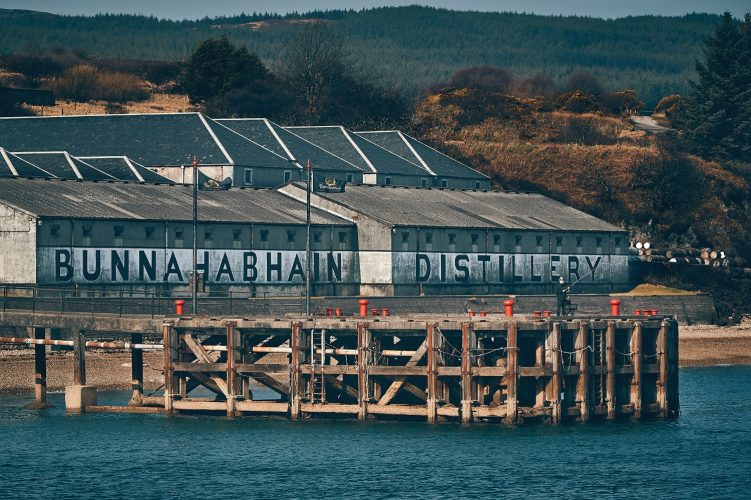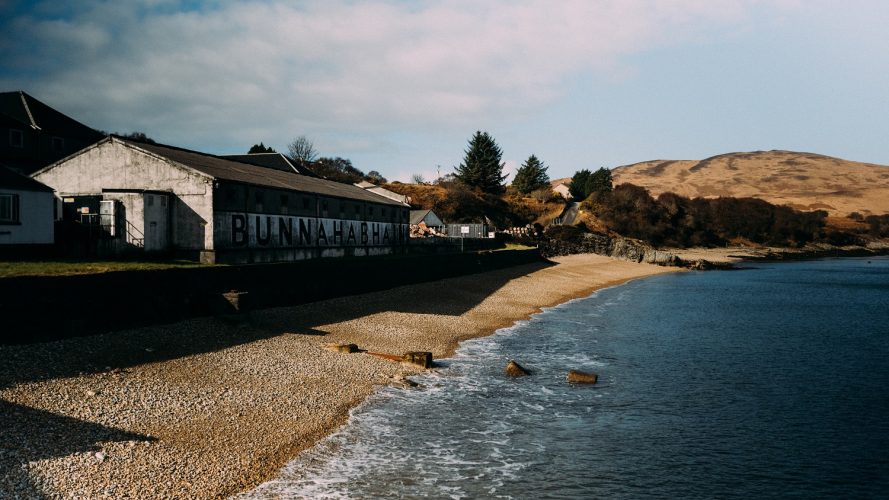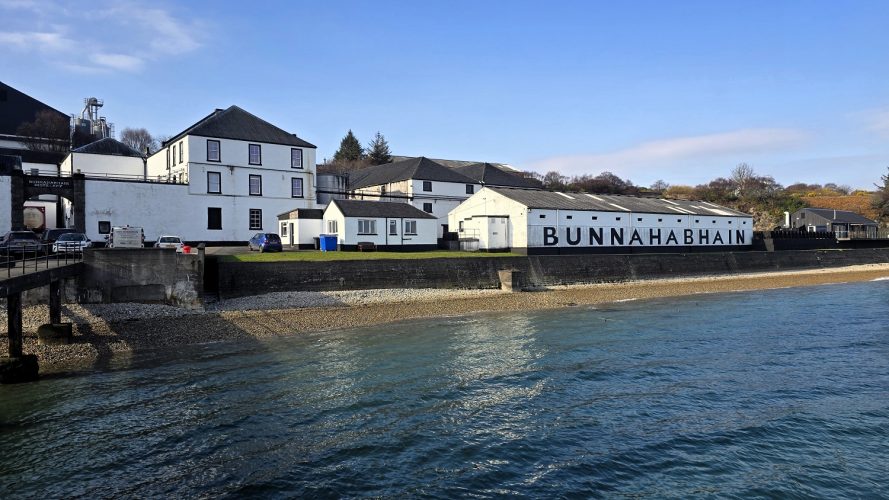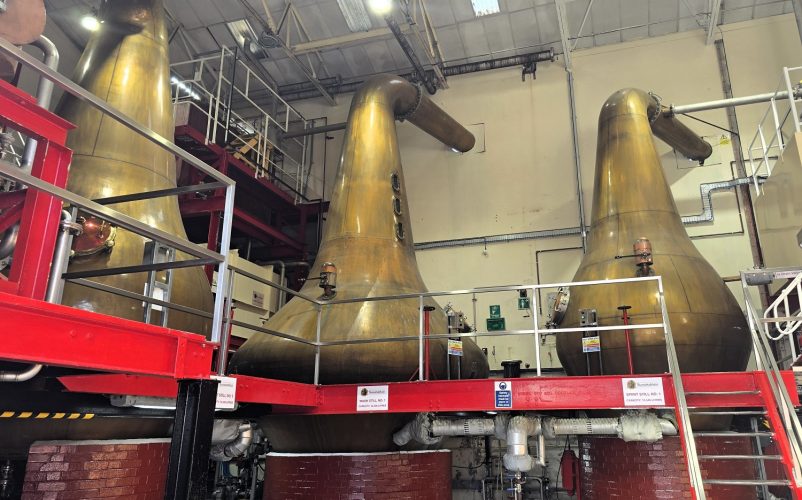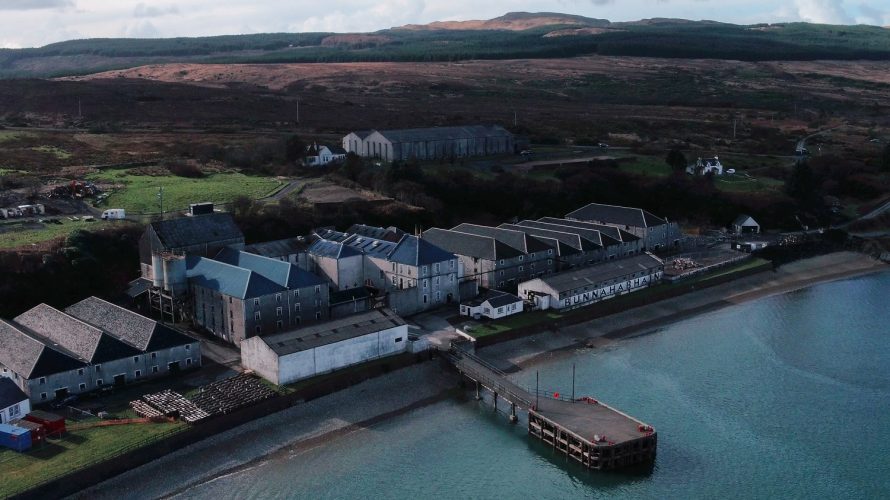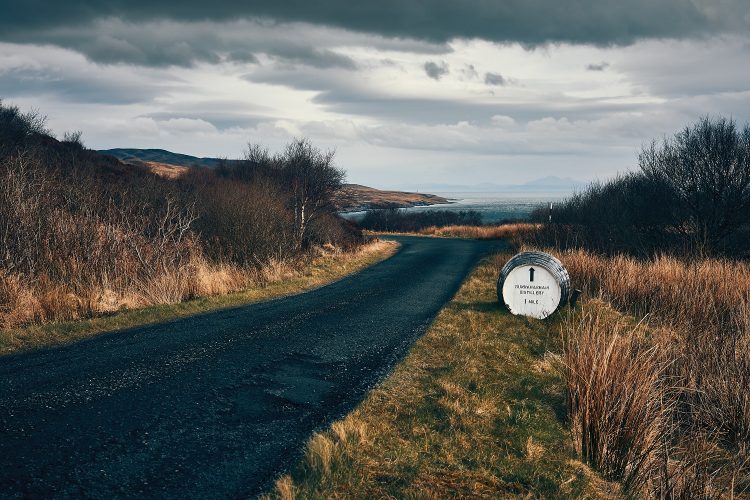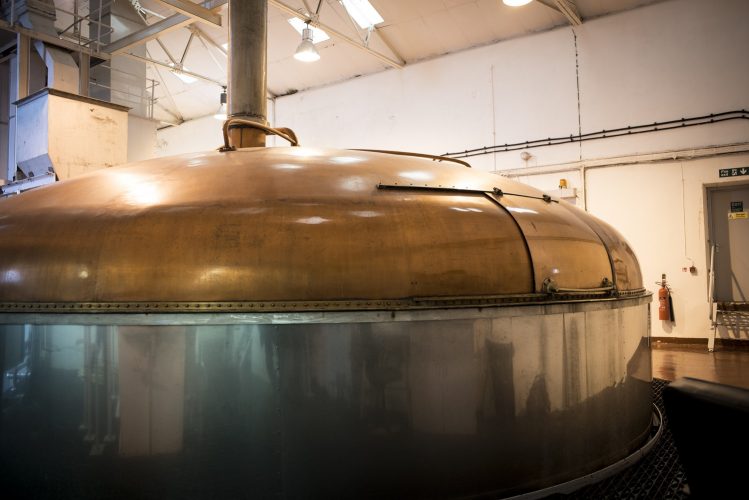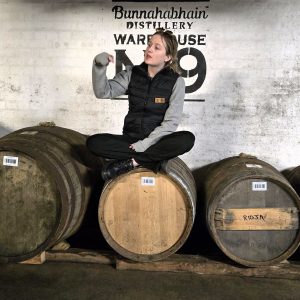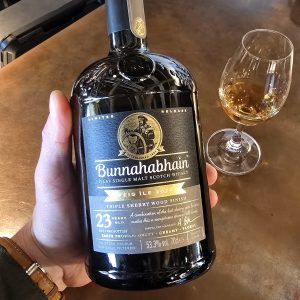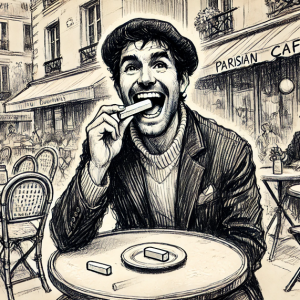Bunnahabhain revealed: A different face of Islay
Γιαννης Κοροβεσης•Articles
A journey to one of the most beautiful — and most unique — distilleries on Islay. The story, the experience, the production, and the casks of Bunnahabhain — seen through a personal tour.
On an island about the size of Corfu, with a population roughly equal to that of Ithaca, just under a dozen distilleries have been operating steadily for centuries. Through highs and lows, they’ve continued to produce what is arguably Scotland’s most iconic product: the heavily peated whisky that has made Islay famous around the world.
I recently visited the island — and the country — with my fellow whisky enthusiast, the great Ioannis Aikaterinidis. Together, we had the chance to explore several of our favorite distilleries. Our second day on Islay was dedicated to its northernmost and one of its most scenic distilleries, the one with the tongue-twisting name — the legendary Bunnahabhain (pronounced Boo-na-hav-en).
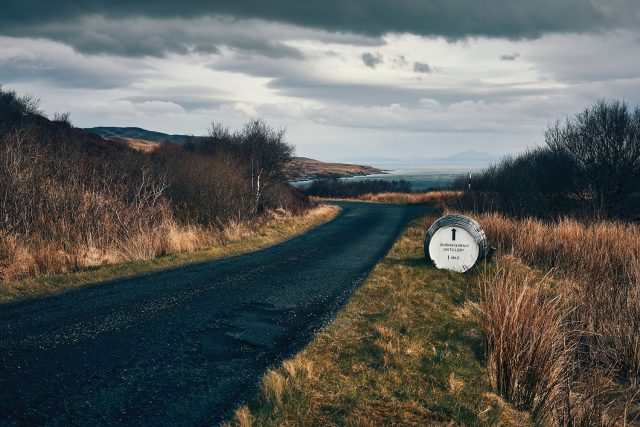
Στον δρόμο για το αποστακτήριο του Bunnahabhain
Getting to Islay isn’t exactly easy. Tucked away in the southwestern reaches of Scotland, part of the Hebridean island chain, Islay can be a bit of a journey to reach. But for those willing to pay tribute to its legendary distilleries, there are two main ways to get there, starting from three different points. A small plane with limited flights from Glasgow lands you in the heart of the island. Alternatively, there’s a ferry, which docks either at the southern port of Port Ellen or further north at Port Askaig — the narrowest point of the Sound of Islay, where the island faces its rugged neighbor, Jura. From there, you head north along the island’s one and only road — a route that didn’t even exist until the 1960s, when it was built solely to serve the Bunnahabhain distillery. As you approach, you’ll notice a barrel by the roadside with an arrow pointing the way: “To Bunnahabhain.” On the way back, the reverse side of the barrel helpfully reminds you that the road now leads “To Other Places”…
The birth of Bunnahabhain
This remote location was strategically chosen by entrepreneur William Robertson (of Robertson & Baxter) along with brothers James and William Greenlees of the Islay Distillery Company as the site for what would become the Bunnahabhain distillery. Its name, in Gaelic, means “Mouth of the River” — a reference to the River Margadale, which meets the sea right at that point. Around the distillery, a small village was built to house the Bunnahabhain workers. Back then, there were no roads connecting the site to the island’s main towns.
So, alongside the distillery, the original founders constructed a working pier. Ships would dock there to unload raw materials and take on casks of whisky. Everything the distillery needed arrived by sea, which makes the brand’s logo especially fitting: a warmly dressed sailor holding a ship’s wheel — a nod to Bunnahabhain’s maritime past. (In the older version of the logo, the sailor held his hand to his brow, peering into the distance.)
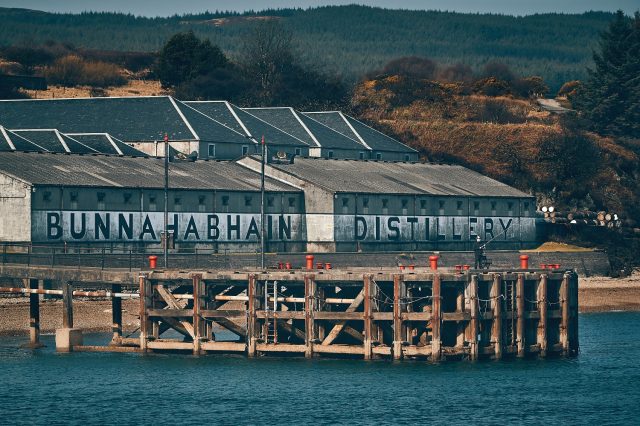
Bunnahabhain was founded in 1881, with production beginning two years later, during the late Victorian era — a time when demand for single malt whisky was rising, particularly for blending with grain whiskies to create the increasingly popular Scotch blends. Locals call it “The Bunny,” while among whisky lovers it’s often affectionately shortened to “Bunna.” In those early days, Bunnahabhain produced a heavily peated spirit, yet somehow, it managed to bring a balance to Scotch blends, making it a highly sought-after component. In 1887, however, the Islay Distillery Company merged with William Grant & Co. — then owners of Glenrothes in Speyside — forming what would become the Highland Distilleries Company. By 1920, this new entity had expanded its portfolio to include Glenglassaugh, Tamdhu, and Highland Park, and at its peak, was supplying malt to as many as 180 different blenders. That early period firmly established Bunnahabhain’s reputation as a go-to single malt for blends such as Famous Grouse, Cutty Sark, and Black Bottle.
Like many distilleries, Bunnahabhain’s journey wasn’t without its challenges. Although it never experienced prolonged closure like some of its peers, it did shut down operations between 1930 and 1937 due to the decline in demand caused by American Prohibition. It also closed for two years during World War II and again between 1982 and 1984. Other periods saw production significantly scaled back.
A change in philosophy
Up until the 1960s, Bunnahabhain exclusively produced peated single malt — in the range of 35–40 ppm — all of which was destined for blending. But from the ’60s onwards, the distillery began to respond to rising demand for unpeated whisky. It shifted to producing a non-peated spirit, discontinued its traditional floor malting, and upgraded and expanded its facilities — nearly doubling its production capacity. It wasn’t until the 1970s that Bunnahabhain began bottling its own single malt under its own name. If memory serves right, the first official bottling came out in 1979 — a whisky that proudly bore the name Bunnahabhain on the label.
Until 1999, the brand remained under the ownership of Highland Distillers, before being absorbed by Edrington, which already held a minority stake in the company. In 2003, Edrington sold Bunnahabhain to Burn Stewart Distillers, owners of Tobermory and Deanston. Not long after, the decision was made to reintroduce peated whisky into the production — albeit in very small quantities and at much lower ppm. Today, Bunnahabhain is part of the CVH Spirits portfolio, alongside Deanston, Tobermory/Ledaig, and Black Bottle.
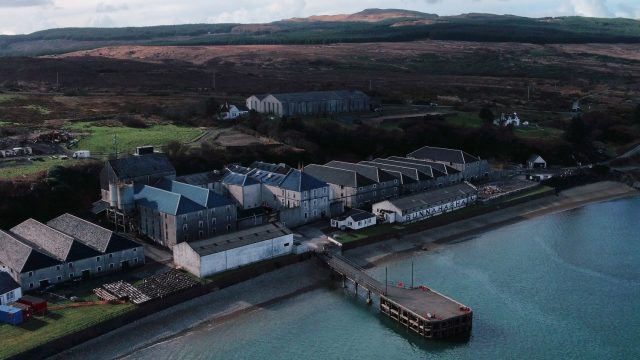
Did I mention I visited the distillery?
Bunnahabhain sits quite literally on the edge of the sea. The shoreline is scattered with pebbles and rocks draped in seaweed, and as our guide Tilly — a young Englishwoman who moved to Scotland with her farmer parents — told us, seals often lounge there under the shy Scottish sun, alongside the classic seabirds of the Hebrides. The Margadale River, which flows into the sea at this very point, is now the distillery’s sole water source. It’s fed by underground springs rich in minerals — in fact, Bunnahabhain is the only distillery on the island that draws its water from subterranean aquifers.
Overlooking the waves are the distillery’s new tasting rooms and visitor shop, as well as a few staff cottages. The production facilities are right next door, still hugging the coastline. And yes — the old pier is still standing. While it no longer welcomes supply ships, it does serve as the occasional launchpad for a bracing swim now and then.
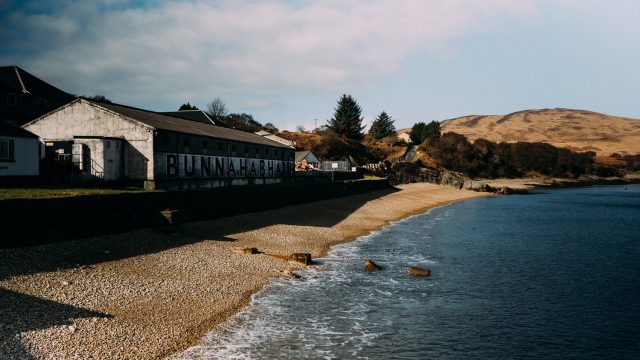
A tour of Bunnahabhain’s facilities
Entering the production area, the first thing you see is the iconic Lauter-style mash tun — a stainless steel vessel topped with a gleaming copper lid. It’s without a doubt the largest mash tun on Islay, and among the largest in all of Scotland. Although Bunnahabhain still has its traditional malting floors, the distillery now sources its malted barley from the Port Ellen maltings. The malt is then ground in a classic Porteus mill, dating back to the 1960s. In the past, the mash tun could process up to 15 tons of grist in a single batch. These days, it typically handles around 12.5 tons. The mashing process takes about 12 hours and involves four water infusions. The first two are used in fermentation — transferred to the washbacks at 64°C and 80°C respectively. The third and fourth waters, heated to 90°C, are combined with the spent grain (draff) and repurposed — either as biomass fuel or as livestock feed.
Fermentation takes place in enormous wooden washbacks, each made from Canadian Douglas fir (also known as Oregon pine), with a capacity of 66,500 liters each. Fermentation occurs in two cycles: the first lasts 48 hours, while the second stretches to 110 hours, allowing for greater depth and complexity in the resulting wash.
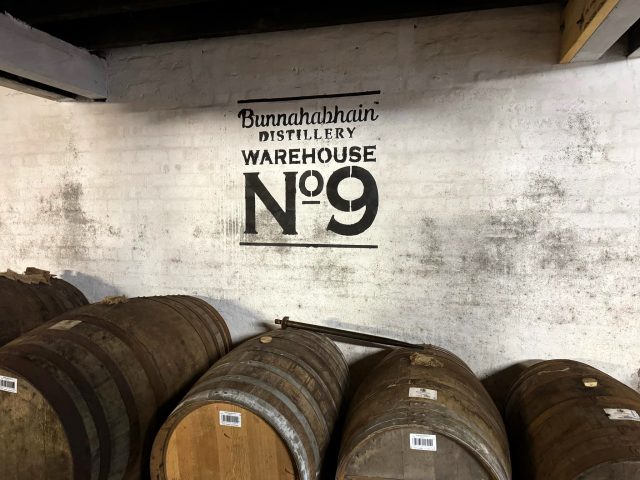
Το Warehouse #9
It seems that everything at Bunnahabhain is… big — including its copper stills, which are the tallest on the island and among the tallest in all of Scotland. The distillery operates with four stills: two wash stills for the first distillation of the fermented wash, and two spirit stills for the distillation of the low wines. The wash stills have a capacity of 35,386 liters, while the spirit stills hold 15,546 liters each.
Their height and pear-shaped design promote reflux, meaning only the lightest vapors manage to reach the condensers. Bunnahabhain produces two different new makes, with two separate cut points for the heart of the distillate. The cut for the peated new make happens slightly later, as phenolic aromas emerge more slowly during distillation. This creates a subtle difference in final alcohol strength, but on average, the new make comes off the still at around 68% ABV. It is then diluted with water and filled into casks at approximately 63% ABV.
The influence of the sea breeze on Bunnahabhain
Unlike many of Islay’s distilleries, which send their new make to mature in mainland warehouses, Bunnahabhain ages its spirit on-site in traditional dunnage warehouses — low, earthen-floored buildings with thick stone walls. These warehouses currently hold around 15,000 casks, with room for up to 20,000.
Their proximity to the sea gives Bunnahabhain its distinctive salty character — that maritime signature often found in island whiskies. It’s said that the sea air, which the casks “breathe,” truly influences the whisky’s flavor. The cool coastal climate also affects the rate of evaporation, subtly shaping the Angels’ Share.
The majority of casks used are ex-sherry (mainly Oloroso), though there are also plenty of ex-bourbon barrels, along with a few ex-port and various wine casks.
In one of these warehouses — the famed Warehouse No. 9 — our guide Tilly led us in for a cask tasting. There, we sampled three unpeated Bunnahabhain expressions and one heavily peated whisky from a Staoisha cask — “Staoisha” being the trade name used by independent bottlers for Bunna’s heavily peated spirit. Each whisky was strikingly different from the next, and the combination of tasting straight from the cask, exploring the shadowy warehouse, and listening to Tilly’s passionate storytelling made for a truly unforgettable experience.
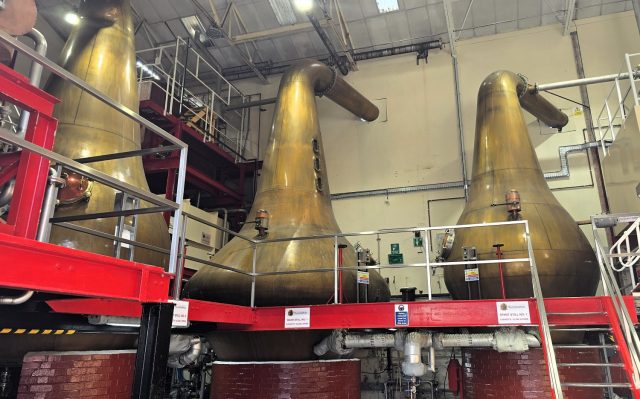
Τρεις από τους τέσσερις άμβυκες – όσοι χωρούσαν στη φωτογραφία
People, numbers, and the brand’s philosophy
Today, Bunnahabhain’s production capacity is around 2.5 million liters per year. And due to consistent demand, the distillery is operating close to full capacity — placing it among the top producers on Islay, likely second only to Caol Ila.
All age-statement bottlings in the brand’s core range use unpeated new make, while the peated expressions are typically labeled “Mòine” — the Gaelic word for peat. Bunnahabhain releases its whiskies at slightly higher-than-standard strength (46.3% ABV), and for the past fifteen years or so, the brand has proudly avoided chill filtration before bottling.
The current distillery manager is Andrew Brown, who’s been with Bunnahabhain since 1988. The master blender — and also the person overseeing all distilleries within the CVH Spirits group — is Julieann Fernandez-Thomson, one of the youngest master blenders in the entire Scotch whisky industry.
It’s also worth noting that the blending and bottling of Bunnahabhain whiskies takes place in Glasgow — a decision driven by logistics, naturally.
After the tour, we made our way to the Bunnahabhain visitor centre, where — with the sea as our backdrop — we sampled a range of exceptional whiskies. Highlights included the Bunnahabhain 23 Year Old 1999 Triple Sherry Wood Finish – Fèis Ìle 2024, the Bunnahabhain Double Wood: New Acquaintance, and the Bunnahabhain 21 Year Old – 2024 Edition.
If you’re a Scotch whisky lover and you ever plan a trip to the enchanting island of Islay, don’t miss the chance to visit Bunnahabhain at the island’s northern tip. The location, the immersive experience, and the outstanding whiskies — some of which are only available on-site — more than justify the long journey to the Hebrides.
For those who choose to stay under the Greek sun, rest assured that many of the brand’s expressions — certainly the entire core range, and occasionally limited editions — are available locally. All are imported and distributed by Concepts.



